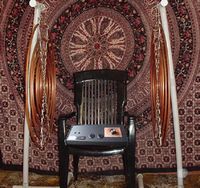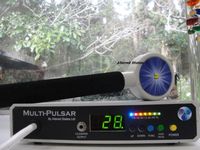Understanding Blood Tests
Peer Review Status: Internally Reviewed by Cancer Center
Staff |
Cancer Treatment and Your Blood Cells
| Common Sites of Infection
|
Cancer Treatment and Your Blood Cells
The goal of cancer treatment, including chemotherapy and radiation therapy, is to interfere with the growth of the cancer cells and destroy them. However, some of the body's normal cells, especially the blood cells, are sensitive to these treatments and may be damaged. Some medications can also slow down the production of blood cells. Fortunately, your body can repair damaged normal cells, making most of the side effects of cancer treatment temporary. To understand this better, it is helpful to know about the bone marrow and the cells it produces.
Bone Marrow
The body is made up of different kinds of cells. Most types of blood cells are made in the bone marrow. The bone marrow is the soft, spongy tissue found in the center of the large bones. All cells made in the bone marrow start out as a single kind of cell called a stem cell. Depending on what type of cell the body needs, a stem cell can become one of three major types of blood cells, a red cell, a white cell, or a cell that makes platelets. Blood cells must be mature to carry out their jobs properly.
Blood Cells
Red blood cells, also called erythrocytes, contain hemoglobin that gives red blood cells their color and carries oxygen from the lungs to the cells. If the number of erythrocytes is low, a patient may feel tired or short of breath.
The platelets or thrombocytes are tiny particles that help the blood to clot or stop bleeding when there is an injury. If the platelets are low, a patient may bleed or bruise easily.
The white blood cells, or leukocytes, are an important part of the body's immune system. There are several types of white blood cells that help to prevent and fight infections.
The Complete Blood Count (CBC)
A complete blood count, or CBC, is a blood test done to determine if the bone marrow is working normally. A CBC describes the number, type and form of each blood cell. The count itself is usually done by a machine called a "Coulter counter" that performs several tests automatically on the blood sample. The CBC includes all of the following tests.
Three tests (the Red Blood Cell Count, Total Hemoglobin Concentration and Hematocrit) measure the amount of red blood cells. in general, they supply similar information. When low, these tests may indicate anemia or excess body fluid. When high, they may indicate polycythemia (an excessive number of red blood cells in the blood) or dehydration.
Red Blood Cell Count (RBC)
This test counts the number of red blood cells in a single drop (a microliter) of blood. "Normal" ranges vary according to age and sex.
- Men: 4.5 to 6.2 million
- Women: 4.2 to 5.4 million
Total Hemoglobin Concentration
This test measures the grams of hemoglobin in a deciliter (100 milliliters) of blood, which can help doctors determine the severity of anemia or polycythemia. Normal values are:
- Men: 13.2 to 17.7 g/dl
- Women: 11.9 to 15.5 g/dl
Any time that the hemoglobin level drops below 10 g/dl, a patient is considered to be anemic.
Hematocrit
Hematocrit measures the percentage of red blood cells in the sample. Normal values can vary:
- Men: 40% to 52%
- Women: 35% to 47%
Erythrocyte (RBC) Tests
Three tests measure the size of the red blood cells and the amount of hemoglobin contained in each cell.
- Mean Corpuscular Volume (MCV) measures the volume of red
blood cells. Normal is 82 to 99 femtoliters.
- Mean Corpuscular Hemoglobin (MCH) measures the
amount of hemogion±n in an average cell. Normal is 25 to
35 picograms.
- Mean Corpuscular Hemoglobin Concentration (MCHC) measures the concentration of hemoglobin in red blood cells. Normal is 32% to 36%.
White Blood Cell Count (WBC)
This test measures the number of white blood cells in a drop (microliter) of blood. Normal values range from 3,700 to 10,500, but can be altered greatly by factors such as exercise, stress, and disease. A low WBC may be due to chemotherapy, a viral infection, a toxic reaction, or another process in the bone marrow that is limiting production of normal WBCs. A high WBC count may indicate infection or leukemia. An increased risk of infection occurs once the WBC drops below 1,000 microliters.
WBC Differential
This test determines the percentage of each type of white blood cell in the sample. Multiplying the percentage by the total count of white blood cells indicates the actual number of each type of white blood cells in the sample. Normal values are:
| Type | Percentage | Number |
|---|---|---|
| Neutrophil | 50 - 60% | 2,188 - 7,800 |
| Eosinophils | 1 - 4% | 40 - 390 |
| Basophils | 0.5 - 2% | 10 - 136 |
| Lymphocytes | 20 - 40% | 875 - 3,300 |
| Monocytes | 2 - 9% | 130 - 860 |
A serious infection can develop once the total neutrophil count drops below 500 microliters. Another word that is sometimes used for neutrophils is segmented neutrophils or "segs."
Platelet Count
This test measures the number of platelets in a drop (microliter) of blood. Platelet counts increase during strenuous activity and in certain conditions called myeloproliferative disorders, infections, inflammation, cancers, and when the spleen has been removed. Platelet counts decrease just before menstruation. Normal values range from 150,000 to 400,000 per microliter. A count below 50,000 can result in spontaneous bleeding; below 5,000, patients are at risk of severe life-threatening bleeding.
What Do Abnormal Blood Counts Mean?
Red Blood Cells
Red blood cells carry oxygen to the tissues in your body. When your red blood cell count is low, your body tissues do not get enough oxygen to do their work. This results in a condition called anemia. In anemia, the hemoglobin and hematocrit are usually low.
How to recognize anemia
If you are anemic, you may feel:
- tired and/or weak
- dizzy
- short of breath
- pounding in your head or ringing in your ears
Be sure to report any of these symptoms to your nurse or doctor.
What to do when you are anemic
- Get plenty of rest.
- Save your energy by having short periods of activity and by resting between activities.
- Consider what is important for you to get done at these times and spend your energy on accomplishing those important tasks.
- To avoid getting dizzy, move slowly. When getting up from a lying position, sit up for several minutes before standing.
- Because there are different causes for anemia, your doctor may have additional advice for you.
Platelets
Platelets help your blood to clot, so that excessive bleeding is prevented when you hurt yourself. If there are not enough platelets in your blood, you may bleed or bruise more easily than usual.
The blood test that measures the platelets in your body is called a platelet count.
How to recognize low platelets
If there are not enough platelets in your blood, you may notice signs of bleeding such as:
- nosebleeds
- easy bruising
- prolonged bleeding from a cut
- black or bloody stools
- brown or red urine
- tiny pinpoint sized red or purple spots on your skin or on your gums
Be sure to notify your nurse or doctor of any of these symptoms.
What to do when your platelet count is low
- Do not take aspirin or any medications containing aspirin. Acetaminophen is a safe substitute.
- Use a sponge-type toothbrush or cotton swabs to clean your teeth. Do not floss.
- Be careful when using knives or tools.
- Do not climb a step stool or ladder.
- Shave only with an electric razor.
- Avoid contact sports.
- Wear protective gloves when working in the yard or with thorny plants.
- Clean your nose by blowing gently.
- Check with your nurse or doctor before seeing your dentist.
- If you should cut yourself, put a clean cloth or paper towel over the cut, applying pressure for several minutes. If the bleeding does not stop, call your nurse or doctor.
- If you should have a nosebleed, apply pressure or ice over the bridge of your nose for several minutes. If the bleeding does not stop, call your nurse or doctor.
The doctor may want you to have a platelet transfusion to increase your platelets when bleeding does not stop.
White Blood Cells
White blood cells help to protect your body by fighting bacteria that cause infection. It is important to protect yourself against infection when your white blood cell count is low.
The blood test that measures your white blood cell count is called a complete blood count or CBC.
How to recognize an infection
When your white blood cell count is low, you may not have the usual warning signs of an infection, such as pus, redness or swelling. Signs you should watch for may include:
- a temperature (fever) over 100 degrees
- shaking chills
- loose bowels for more than two days
- a burning feeling when passing urine
- a cough
- a sore throat
- a general feeling of tiredness or "flu-like" symptoms
If any of these symptoms occur, be sure to notify your nurse or doctor promptly.
What to do to help prevent infection
Certain areas of the body are frequent sites of infection. Regular examination for signs of infection can lead to early detection. Careful hand washing by you and your family is the most effective way of decreasing the chance of infection.
Mouth
Good mouth (oral) care is very important. Your doctor or nurse will tell you how often to examine your mouth. Areas you need to check include inside and around the lips, under the tongue, around the edges of the teeth, on the roof of the mouth and on the inside of the cheeks. If you have dentures, they should be removed before you examine your mouth. Sometimes soreness in the mouth or an increased sensitivity to hot or cold foods may be an early sign of oral problems. Oral infections may appear as tender red, or white, raised patches.
Preventive Measures
- Brush your teeth after every meal and at bedtime. A soft-bristle toothbrush should be used carefully to avoid injury to the gums. Replace your toothbrush frequently, especially after any mouth infection.
- If your mouth is sore, rinse well with water or a diluted salt-water solution. Avoid commercial mouthwashes, which often contain alcohol that can burn and dry your mouth.
- Acidic foods, such as tomato, orange, and grapefruit juices should be avoided. Use spices and salt in moderation, and avoid tobacco and alcohol.
- For further protection, the mouth and lips may be coated with a water-based lubricant, such as Johnson & Johnson's K-Y Brand Lubricating jelly.
Skin
The skin is, in many cases, the first line of defense against infection. When the skin is broken, the chance of infection increases. You can help prevent germs from entering the body by avoiding cuts and scratches, and by keeping the skin clean. Regular self-examination of your skin is very important. Any changes (rashes, sores or cuts) you note should be reported to your doctor.
Preventive Measures
- Wear shoes or slippers when walking.
- Wear gloves when working in the garden or washing dishes.
- Use an electric razor when shaving.
- Wash hands after each visit to the bathroom.
- Use lotion or oil to soften dry skin.
- Clean any scrape or cut right away with warm water and soap.
- After each bowel movement, clean your rectal area gently but thoroughly. If you have hemorrhoids, ask your nurse or doctor for advice.
- Check with your nurse or doctor before having dental work.
Lungs
The lungs are the only major internal organ of the body exposed to air and easily reached by air carried germs. It is important to recognize early signs of lung infection and report them to your nurse or doctor promptly. Possible signs of lung infection are:
- Shortness of breath
- Coughing up of sputum (phlegm)
- Chest pain when taking a deep breath
Preventive Measures
- Avoid crowds if possible. Shop during the least busy hours.
- Avoid close contact with sick children or adults.
- Avoid grooming pets and other pet-care tasks, such as cleaning bird cages and cat litter boxes.
- Avoid smoking and smoky rooms.
- Keep as active as possible, avoiding prolonged periods of bedrest.
Urinary Tract and Bowels
The groin is an area that harbors many germs and where germs can easily enter the body. This may result in urinary tract infection or infection in the lower bowel. Thorough cleaning of the area after bowel movements may help to reduce the chance of infection. Constipation can lead to straining, which may cause a tear in the lower bowel, leaving an opening, for germs to enter.
Be sure to report any of the following symptoms to your nurse or doctor:
- mucous or other abnormal discharge from the urinary tract
- pain or burning during urination
- increase in the urgency or frequency of urination
- lower back pain or pain above the pubic area
- blood in the urine
- chills, fever, nausea, vomiting
- painful bowel movements
To prevent constipation
- Increase the bulk in your diet by adding raw fruit, vegetables, whole wheat and grain. Be sure to wash fresh fruit and vegetables thoroughly before eating. If your white blood cell count is low, your doctor may restrict your intake of raw fruits and vegetables.
- Drink at least eight to twelve glasses (8 ounces) of liquids every day.
- Avoid the use of suppositories and enemas.
Sex during therapy
- Cleanliness and proper lubrication during sexual relations should be maintained.
Feminine hygiene
- Women should check with their doctor or nurse before douching.
- During menstruation, sanitary pads should be used instead of tampons.
- After bowel movements, it is particularly important for women to wipe from front to back.
- Consult your doctor whenever you experience any of the symptoms of anemia, low platelets, or infection, as have been described.
- Practice self-care as described under preventive measures.
- Maintain nutrition and good hygiene. For example:
- eat a well-balanced, high calorie, high-protein diet
- drink eight to twelve glasses (8 ounces) of fluid every day
- shower or bathe daily
- You may have important questions to ask about your disease, and your doctor and nurse are the best people to provide answers. If you have questions or concerns about your treatment, do not hesitate to discuss these. It may be helpful to write out your questions.
This information is written primarily for patients.
All contents copyright © 1992-2004 the Author(s) and The University of Iowa. All rights reserved.
https://www.vh.org/adult/patient/cancercenter/bloodtests/index.html
 |
The worlds most advanved multi purpose Fully Automatic Rife/Hoyland System here |
 |
Rife machines and Multiwave oscillators are claimed to complement each other based on the principle that life forms absorb energy. A multiwave Oscillator uses this principle to strengthen cells within the body to resist disease while a Rife machine uses this principle to destroy microorganisms with an overdose of frequency energy. |
 |
PEMF Pulser combo |